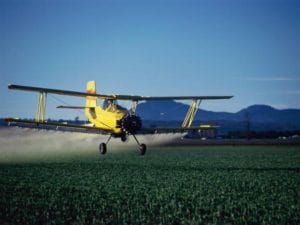Canada.com
by Margaret Munro
 Amid growing concern that fungicides are fuelling the rise of resistant and life-threatening fungus in Europe, China and India, a microbial sleuth says it is time to start filling in the gaps in Canada.
Amid growing concern that fungicides are fuelling the rise of resistant and life-threatening fungus in Europe, China and India, a microbial sleuth says it is time to start filling in the gaps in Canada.
As a first step, biologist Jianping Xu says his group at McMaster University in Hamilton, Ont., hopes to start testing fungi circulating in southern Ontario’s farm belt this fall.
“We plan to take samples in the environment and compare them with what we see in patients in the hospital,” says Xu, who has collaborated on several international studies that point to resistant fungi as a growing and serious health threat.
He and his colleagues say agricultural fungicides known as triazoles, which are sprayed on everything from corn to canola in Canada, appear to be driving emergence of fungi that are resistant to not only agricultural fungicides but closely related medicines. Triazole-based drugs are the first-line defence against Aspergillus fumigatus, which can cause a range of conditions from wheezing in asthmatics to deadly lung infections in individuals with weakened immune systems.
Aspergillus is a ubiquitous fungus that feeds on dead animal or plant matter and spreads by producing spores that float through the air. The fungus, common in soil and compost heaps, causes serious infections in more than three million people a year.
Last week, a British-Dutch team reported that fungicide use on crops is the likely reason Aspergillus fumigatus found near British farms has developed resistance to life-saving antifungal drugs.
“The clear association with triazole fungicide usage is very worrisome, as some unlucky people at risk will breathe in untreatable Aspergillus, with potentially dire consequences,” lead author Dr. Michael Bromley, at the University of Manchester, said in releasing the study.
Resistant fungi is also seen in Europe, India and China where researchers point to agricultural fungicides as a likely culprit.
In a study published in June, Xu says he and colleagues in China found 29 per cent of 313 types of yeast samples taken from the mouths of hospital patients in Hainan were resistant. Yeast is a type of fungus. Xu says the findings came as a surprise as none of the patients were taking triazole medications that can also lead to emergence of resistant organisms.
One possible explanation is that the patients picked up the resistant yeast from the environment before arriving in the hospital, reports the team, noting that use of triazole fungicides increased 48 per cent in China between 2000 and 2011.
Xu, who specializes in the fungi genetics, has also been assessing Aspergillus fumigatus samples from India. He and his colleagues from India and the Netherlands uncovered resistant strains in soil in tea gardens, rice paddies and even flower pots in a hospital garden. The type of resistance seen in the fungi is consistent with agricultural fungicides in the environment causing “cross resistance to medical triazoles,” the team reported in the journal PLOS ONE.
Resistant fungi add a new dimension to the type of organisms moving from “farm-to-fork.” Antibiotics used on chickens, pork and cattle farms have long been known to fuel emergence of resistant bacteria that can infect people.
While the link between fungicide use and resistant Aspergillus has not been conclusively proven, the European Centre for Disease Prevention and Control has flagged it as a concern that warrants more attention.
Xu would like Canada to step up monitoring of fungi in both hospitals and the environment to better track resistance and tailor treatments.
Health Canada, which regulates pesticide use in Canada, could provide no information on the monitoring of fungal resistance in Canada and had little to say about the reports linking fungicide use to resistant fungi that pose a health threat.
“Health Canada scientists continually review scientific studies to ensure the Department remains effective in protecting the health and safety of Canadians,” Sara Lauer, a Health Canada media officer, said in an email response to a request for comment.
A representative for industry says Canadian farmers rotate the type of fungicides they use to try to prevent fungi from developing resistance.
“They rotate their chemistry and rotate their crops,” says Pierre Petelle, vice-president of chemistry at CropLife Canada, which represents pesticide companies. He stressed in an interview Thursday that fungicides prevent fungal diseases on crops, some of which harm not just plants but can also produce toxins that can impact animals and humans.
Petelle is not aware of wide-scale resistance to triazole pesticides emerging in Canada. “We don’t see any evidence of that,” he said.
He has not yet read the reports suggesting a link between fungicides and resistant human pathogens, but is skeptical.
“To look at agriculture as the culprit, I am not sure about that,” said Petelle.

